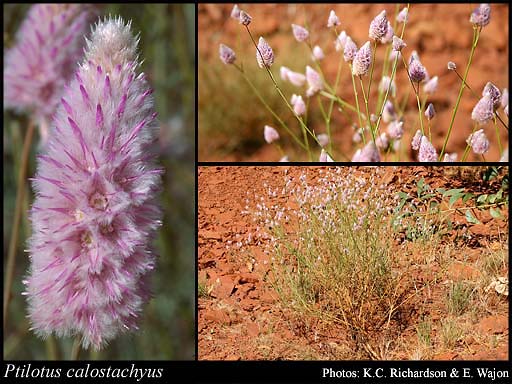- Reference
- Fragm. (Mueller) 6:231 (1868)
- Conservation Code
- Not threatened
- Naturalised Status
- Native to Western Australia
- Name Status
- Current
Erect or spreading perennial, herb or shrub, 0.2-2 m high. Fl. pink-white, Mar to Oct. Red sand, stony sand. Variety of habitats.

Scientific Description
Perennial herbs or annuals, stems single, more or less erect, glabrous. Leaves present, 10-90 mm long, 1-3 mm wide, glabrous; basal rosette absent; cauline leaves alternate. Spikes pink, cylindrical, solitary, with densely arranged flowers. Bracts (1.2-)1.7-3.2 mm long, colourless, glabrous or hairy, not awned or mucronate, with an obscure midrib. Bracteoles (1.1-)2-3 mm long, colourless, glabrous or hairy, not awned or mucronate, with an obscure midrib. Outer tepals (3-)3.3-6 mm long, entire. Inner tepals (3-)3.3-5.8 mm long, glabrous within. Style 1.4-2.5(-2.7) mm long, straight, centrally fixed to ovary. Seeds (1.1-)1.3-1.5 mm long, glossy, brown. Distribution: Northern and Eremaean Botanical Region; IBRA regions: Central Kimberley, Dampierland, Ord Victoria Plains, Victoria Bonaparte.
Distribution
- IBRA Regions
- Central Kimberley, Central Ranges, Dampierland, Gascoyne, Gibson Desert, Great Sandy Desert, Great Victoria Desert, Little Sandy Desert, Ord Victoria Plain, Pilbara, Tanami.
- IBRA Subregions
- Ashburton, Augustus, Chichester, Dune Field, Fortescue, Hamersley, Hart, Lateritic Plain, Mackay, Mann-Musgrave Block, McLarty, Pentecost, Pindanland, Purnululu, Roebourne, Rudall, Shield, South Kimberley Interzone, Tanami Desert, Trainor.
- Local Government Areas (LGAs)
- Ashburton, Broome, Derby-West Kimberley, East Pilbara, Halls Creek, Karratha, Laverton, Meekatharra, Ngaanyatjarraku, Port Hedland, Upper Gascoyne, Wyndham-East Kimberley.